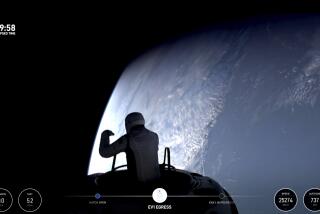American, Russian Join in Spacewalk to Inspect Mir Hull
- Share via
MOSCOW — An American astronaut and a Russian cosmonaut floated outside the Mir space station today on a rare U.S.-Russian spacewalk to search for punctures from the worst space collision ever.
Astronaut Michael Foale and Mir commander Anatoly Solovev, who was making his 10th spacewalk, were trying to pinpoint the holes on the damaged Spektr module, leaving the actual repair work for a later mission.
The two men began the scheduled six-hour expedition just before 5 a.m. today Moscow time. After exiting the Kvant 2 module, they were moved by a boom to the Spektr, at the opposite end of the space station, which is shaped like a giant cross.
“I can’t see anything yet,” Solovev said as he examined the Spektr’s radiator, considered a likely site for one or more of the holes. About two hours into the spacewalk, Solovev was breathing heavily, but said he felt fine.
He used a knife to scrape away coating on the radiator, sending small pieces of debris drifting into space like snowflakes.
“The more [Anatoly] does that, the more the pieces are flying around and the less I can see,” said cosmonaut Pavel Vinogradov, who was filming the spacewalk from the Soyuz escape capsule.
At Russia’s Mission Control just outside Moscow, the deputy chief of the mission, Valery Udaloy, said, “everything is going according to schedule.”
The walk was the first hands-on inspection of the Mir’s damaged hull since a remote-control supply ship rammed the space station June 25, slashing power and raising questions about its viability.
“It’s very hard work. I hope that everything will be fine,” said Yuri Semyonov, the chief designer of the Mir.
Most of the power has been restored following a repair mission inside the ruptured Spektr module last month. The American-Russian team, besides looking for holes and videotaping damage, hoped to restore even more energy by realigning at least one of the module’s three undamaged solar panels.
Solovev, now on his fifth Mir mission, was to do most of the work on the solar panel and search for the holes on the Spektr module.
“It does not mean that Foale is playing a secondary role,” Udaloy said. “The roles of both of them are equally important.”
Even if the depressurized Spektr can’t be fixed, the work is seen as invaluable experience for the international space station being launched next year.
As on every spacewalk, the main safety hazards were sharp edges on the outside of the station that could rip the spacewalkers’ suits. Any such tear in open space could be fatal.
Loaded down with tools and flashlights, the two spacewalkers had enough air to last more than seven hours outside, but were told not to cut it too close.
More to Read
Sign up for Essential California
The most important California stories and recommendations in your inbox every morning.
You may occasionally receive promotional content from the Los Angeles Times.










